
A timeline of the decades-long peace negotiations that came before the Israel-Hamas war.
Even though Israel has approved a temporary ceasefire in its unprecedented assault on Gaza following Hamas’s October 7 attack, Israeli Prime Minister Benjamin Netanyahu has made clear that he still believes it is a “time for war,” not for peace.
On Tuesday, he vowed that the war will continue “until Hamas is destroyed, all the hostages are released and there is nobody in Gaza who can threaten Israel.”
But while US leaders have supported the Israeli war effort, they have also held out hope for an eventual two-state solution in which Israel and a sovereign Palestine exist side by side: “The only ultimate answer here is a two-state solution that’s real,” US President Joe Biden said recently.
The two-state solution isn’t the only approach to solving the Israel-Palestine conflict. But it is the mainstream one; it’s been the international community’s approach for the last several decades. The idea is that US-brokered negotiations can lead to a peace treaty, or a “final status agreement,” which would establish a Palestinian state in Gaza and the West Bank in exchange for a permanent end to hostilities.
But in the three decades since this peace process really began — with the historic Oslo Accords in 1993 — the two-state solution has slipped further away. A lack of political will in Israel, Palestine, and the US, as well as disagreement over the precise contours of the deal, have rendered negotiations unsuccessful. Major sticking points include: what the borders of the two states should be (and where Jerusalem falls in that), whether Palestinian refugees who were forced out of what is now Israel will be able to once again live there (also known as the “right of return”), and how to establish security guarantees for both Israelis and Palestinians. Today, all of these issues remain major impediments to peace.
Violence perpetrated by Palestinian militants such as Hamas — an organization many countries designate as a terrorist group — as well as by Israeli security forces, has eroded trust on both sides. So, too, has Israel’s expansion of illegal settlements in West Bank territory that the international community sought to set aside for Palestine. The more extreme elements of Israeli and Palestinian society, and their political leaders, have forestalled negotiations at critical moments.
Israel and its allies have often laid the blame at the feet of Palestinians for rejecting what they saw as generous offers. “You are leading your people and the region to a catastrophe,” former US President Bill Clinton famously told the Palestinian leader Yasser Arafat when he refused a peace deal proposed at Camp David in 2000.
But Palestinians contend that those offers, no matter how generous by Israeli standards, never went far enough. Israel has always had the military and diplomatic edge in the conflict, with a powerful ally in the US. And Palestinians have been forced to progressively narrow their conception of acceptable peace, let alone a fair peace, especially as Israel treats its territorial expansion as a fait accompli and normalizes relations with Arab countries that had previously fought for the Palestinian cause.
“Palestinians wonder whether they are always doomed to accept what they have previously refused just to find that it is no more an offer — if it ever was an offer — again to be faced with new attempts to extort new concessions from them for an undefined future,” writes Palestinian diplomat Afif Safieh in his 2011 book, The Peace Process: From Breakthrough to Breakdown.
Here is what you need to know about the history of Israeli-Palestinian peace talks and why they have repeatedly failed.
1967: UN Resolution 242
In 1967, Israel fought Egypt, Syria, and Jordan in the Six-Day War, a brief but intense conflict over water, land, and Palestine. Israel defeated the three Arab states, capturing Gaza, the West Bank, the Sinai Peninsula, parts of East Jerusalem, and the Golan Heights.
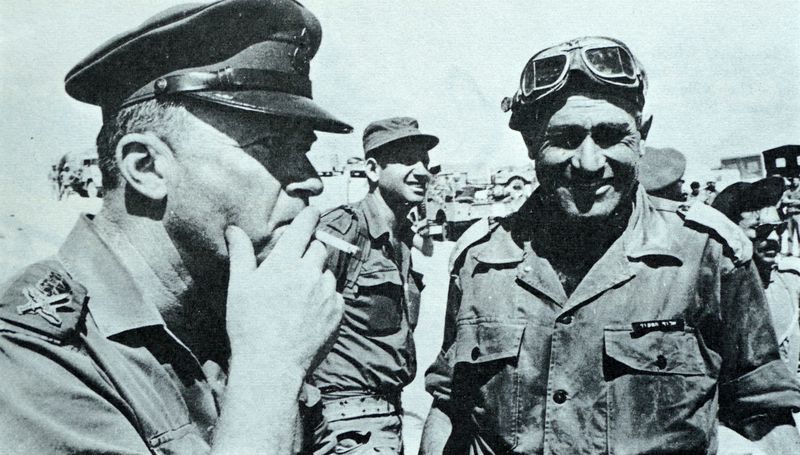
Universal Images Group/Getty Images
Following the conflict, the UN adopted Resolution 242, which calls on Arab countries to recognize Israel’s right to “live in peace within secure and recognized boundaries free from threats or acts of force,” as well as for Israel to withdraw from “territories occupied” in the conflict — essentially, to revert to its pre-1967 borders, a provision that Israel has since resisted.
Israel, Egypt, and Jordan all came to accept the resolution, ushering in temporary peace between them. Egypt and Jordan recognized Israel’s existence and ceased direct hostilities with the country, though Israel didn’t uphold its part of the deal, never fully reverting to its pre-1967 borders — a choice that led to the 1973 Yom Kippur War.
Still, achieving buy-in from Arab nations that were once hostile to Israel was a significant step toward opening formal Israeli-Palestinian peace negotiations. The resolution was later affirmed in 1973 in UN Resolution 338, which, along with resolution 242, served as the foundation of peace talks in the region for decades to come.
1978: Camp David Accords
The Camp David Accords established long-lasting (but cold) peace between Egypt and Israel, and also had a significant impact on the trajectory of Israeli-Palestinian peace negotiations.
The Accords, brokered by then-US President Jimmy Carter, came after a ceasefire in the 1973 Yom Kippur War, in which Egypt and Syria fought Israel, hoping to regain territory lost in previous conflicts. As part of the deal, Egypt and Israel agreed to refrain from use of force to resolve their disputes, and Israel agreed to a path toward returning the Sinai Peninsula to Egypt. (Syria signed a separate disengagement agreement with Israel.)
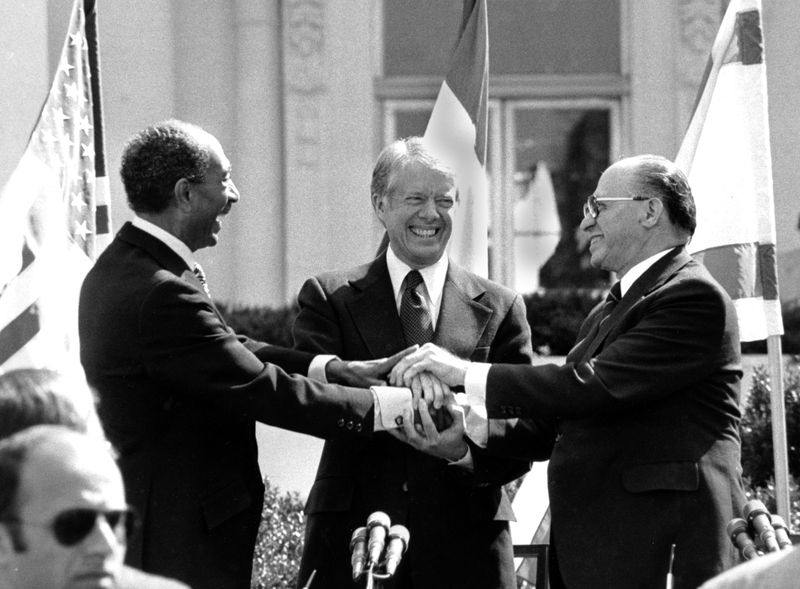
Bob Daugherty/AP Photo
Israel and Egypt also addressed the fate of Palestinians: They reiterated their commitment to UN Resolutions 242 and 338. Both countries called for Palestinians to participate in future negotiations, “full autonomy” for people in the West Bank and Gaza, a provisional government in those territories supported by Israeli security forces, and negotiations to determine Palestinians’ final status within five years. Palestinians were not formally invited to participate in the talks because the US refused to deal with the Palestine Liberation Organization, an umbrella group for Palestinian nationalists, so long as they refused to acknowledge Israel’s right to exist and to renounce terrorism.
The Accords are considered a major watershed moment in Middle East peacemaking — earning then-Israeli Prime Minister Menachem Begin and Egyptian President Anwar Sadat Nobel Peace Prizes — and provided a blueprint for subsequent negotiations.
However, while Israel successfully kept the peace with Egypt, it did not abide by its commitments to Palestinians in the Accords. The five-year deadline for beginning to grant Palestinian people autonomy within the West Bank and Gaza came and went, and Israeli settlements in the occupied territories ballooned.
Carter writes in his 2006 book Palestine: Peace Not Apartheid that by “remov[ing] Egypt’s considerable strength from the military equation of the Middle East,” Israel “permitted itself renewed freedom to pursue the goals of a fervent and dedicated minority of its citizens to confiscate, settle, and fortify the occupied territories.”
Historians — including Seth Anziska, author of the 2018 book Preventing Palestine — have also argued that the Accords had the effect of limiting remedies available to the Palestinians by focusing on establishing an ill-defined goal of “full autonomy” rather than sovereignty.
Essentially, the Accords successfully kept war from breaking out between Israel and Egypt. But in the view of Carter and others critical of the deal’s limitations, the agreement also removed incentives Israel may have had to pursue peace with the Palestinians, setting the stage for the next few decades of difficulties.
1988: Amid the First Intifada, Arafat acknowledges Israel’s right to exist
In 1987, Palestinian frustrations had reached a boiling point following Israel’s invasion of Lebanon to root out the Palestine Liberation Organization (PLO) presence there, the construction of new Israeli settlements, and increased repression by Israeli security forces in the West Bank and Gaza. Palestinians staged their First Intifada, Arabic for “shaking off,” engaging in nonviolent mass protests that often turned into violent clashes with Israeli security forces. It was amid this fighting that Hamas rose in prominence, initially committing to a nonviolent strategy alongside the PLO to facilitate peace talks.

Sven Nackstrand/AFP/Getty Images
With the intifada unfolding, PLO leader Yasser Arafat, known as the father of Palestinian nationalism, made an announcement that paved the way for direct negotiations with the Israelis.
Arafat said that the PLO, which had previously sought to defeat and replace the state of Israel — often via violent means, like airplane hijackings and bombings of Jewish civilians across the globe — had ‘’accepted the existence of Israel as a state in the region’’ and ‘’declared its rejection and condemnation of terrorism in all its forms.’’
“We accept two states, the Palestine state and the Jewish state of Israel,” he said.
Though the initial reception from the US and Israel was icy, it was a significant capitulation. The PLO was still widely regarded as a terrorist group, including by the US, following the announcement. But it would begin to take a more active role in determining the future of the Palestinians.
1991: Madrid Conference
In 1991, representatives from the US, Soviet Union, Israel, Egypt, Syria, Lebanon, and Jordan, as well as non-PLO Palestinian delegates, convened for the first time in Madrid to hold negotiations to create a new framework for the peace process. The conference was conceived by then-US Secretary of State James Baker to change course from a continued pattern of conflict during the final years of the First Intifada.
There were still significant disagreements between the US and Israel around what peace should look like, particularly on settlement expansion, and no formal agreements came of the conference.
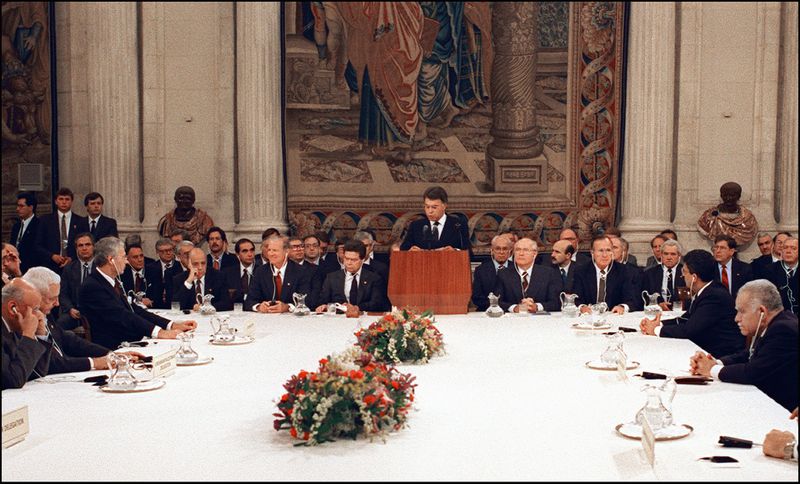
David Ake/AFP/Getty Images
But “what Madrid did achieve was significant,” write George Mitchell, former US President Barack Obama’s special envoy for Middle East peace, and Alon Sachar, a Middle East expert and former adviser to the US Ambassador to Israel, in the 2016 book A Path to Peace. That included bolstering public support for negotiations in Israel, which elected Yitzhak Rabin as prime minister in 1992 on a platform that focused on Israeli-Palestinian peace efforts. Together, Rabin’s election and the hope generated in Madrid laid the groundwork for the first major breakthrough in decades.
1993: Oslo
The year 1993 marked a breakthrough that established the modern peace process as we know it.
The PLO and Israel entered secret negotiations — facilitated by Norwegian politicians through a think tank in Oslo — at a moment when both felt backed into a corner. Israel was facing increasing international pressure to engage in peace talks following its violent clampdowns on Palestinian protesters in the intifada. And the PLO was weakened after supporting Iraqi dictator Saddam Hussein before his defeat by US and international forces in the First Gulf War. The fall of the Soviet Union had also reduced Cold War tensions in the Middle East that had previously made peacemaking difficult.
The secret talks allowed the negotiators to discuss difficult issues without fear of political blowback. After some progress had been made, the Israelis elevated them to official, public negotiations in Oslo. Then-US President Bill Clinton had a limited role in the negotiations, but held a formal signing ceremony for the so-called Oslo Accords on the White House lawn in Washington, DC, in 1993, in which Rabin and Arafat famously shook hands.
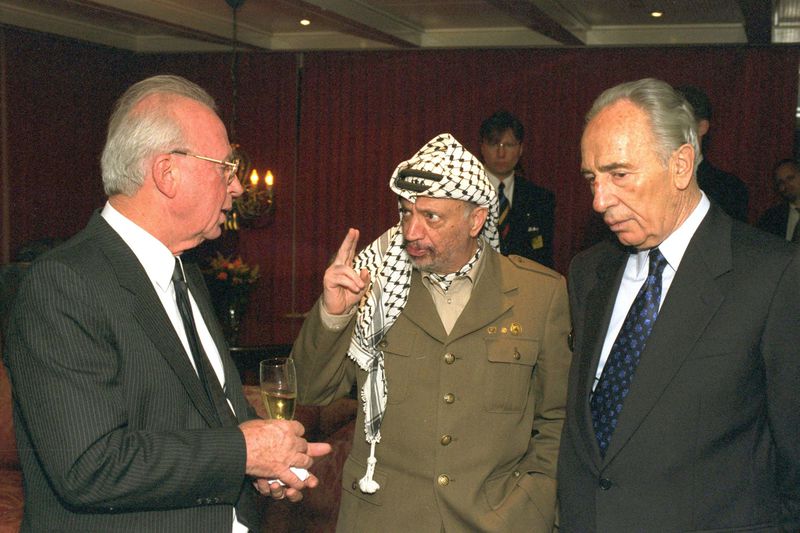
Yaakov Saar/GPO/Getty Images
The Accords allowed Palestinians to self-govern in the West Bank and Gaza and established the Palestinian Authority as the government of those areas. Israel agreed to withdraw its security forces from Gaza and “redeploy” those located in the West Bank in phases. In exchange, the PLO formally recognized the state of Israel and the right of its citizens to live in peace, accepting the language of UN Resolution 242. “To this day Palestinians refer to their acquiescence to 242 as their historic compromise, the moment they accepted partition,” Mitchell and Sachar write.
Critically, the PLO failed to limit Israel’s continued military presence in Gaza and the West Bank in key ways. The agreement provided no timeline for Israel’s withdrawal from Gaza and gave Israelis exclusive jurisdiction over their settlements in the occupied territories. At this time, the settler population there exceeded 280,000 and would increase by almost 70,000 in the following five years.
Meanwhile, the Palestinians were left to manage their own affairs, including administering security and public services, relieving Israel of “formal responsibility for the living conditions and welfare of the territories’ rapidly increasing population, still completely dominated by Israeli forces,” Carter writes.
The Accords also established a five-year interim period in which the thornier issues of the conflict were meant to be resolved once and for all: the fate of a Palestinian state and its borders, whether Palestinian refugees would be able to return to Israel or the Palestinian territories or be compensated, what would happen to Israeli settlers and Jerusalem, and water usage. But that would never come to be.
1995: Oslo II
Oslo II built on the momentum of the first Oslo agreement, which was received positively by both Palestinians and Israelis. In September 1995, Rabin and Arafat convened to sign a second agreement in DC that divided the West Bank into three zones, labeled Areas A, B, and C, keeping Gaza continuous. The hope was that, eventually, the Palestinian state would be formed in these areas.
The newly created Palestinian Authority (PA) was given full control over Area A, which encompassed the Palestinian cities of Ramallah, Jenin, Nablus, and Bethlehem. In Area B, which spans a dense zone around those Area A cities, the Palestinian Authority was to have civil jurisdiction in partnership with Israel, which would administer security. Area C, which represented most of the West Bank (and encompassed all of the settlements that Israel had built since it captured the territory in 1967) was to be administered entirely by Israel. Israel was still permitted to collect taxes from the many Palestinians living anywhere in the West Bank and Gaza if they worked in Israel, which it would then distribute to the PA. The Israelis had agreed to withdraw from most of Gaza ahead of Oslo II.
Rabin also agreed that Israel would withdraw from Areas A and B within three months of the signing of the agreement, and would negotiate further withdrawals in the five-year interim period established in the first Oslo agreement.

Yoav Lemmer/AFP/Getty Images
Radicals on both sides sought to prevent both Oslo I and II’s implementation. Rabin, who had become the face of the peace movement in Israel, was assassinated by a Jewish extremist who opposed the Accords just months later. A period of heightened attacks by Hamas followed. Public support for the peace process eroded, leading to Netanyahu’s election as prime minister in 1996. He opposed the Oslo Accords, arguing they only encouraged attacks like those Hamas was launching at the time, and that Israel needed to take a hard line against the Palestinians. He also distrusted the PLO’s Arafat, a feeling that was mutual.
Netanyahu’s first government wasn’t as far right as his latest one, but decisions he made in the years to come would make negotiations increasingly difficult.
2000: Camp David and the Clinton parameters
Following Rabin’s assassination and Netanyahu’s election, the Accords were threatened, and Clinton tried to salvage the negotiations by inviting Arafat and Netanyahu to Maryland’s Wye River plantation in 1998. There, the leaders agreed to additional Israeli withdrawals from the West Bank as well as Palestinians taking measures to prevent violence against Israel — but both sides accused each other of failing to properly implement the agreement.
That contributed to a deteriorating political situation in Israel, where Netanyahu was facing criticism from the left for failing to make enough progress on negotiations and from the right for making what they saw as unreasonable territorial concessions. Netanyahu was subsequently voted out in 1999, with Ehud Barak taking his place as prime minister and promising an agreement with the Palestinians within 15 months.
At Barak’s urging, Clinton held another summit at Camp David in July 2000, where the leaders failed to come to an agreement on borders, Jerusalem, and Palestinian refugees’ “right of return.” Why they failed is a subject of disagreement: Clinton and other pro-Israel voices have blamed Arafat, arguing that he was unwilling to make peace, while others say the negotiations were designed to fail because they didn’t meet the “minimum requirements of any Palestinian leader,” as Robert Malley, one of the US negotiators, argued several years later. It was nevertheless a blow to Barak, who would not survive long as prime minister.
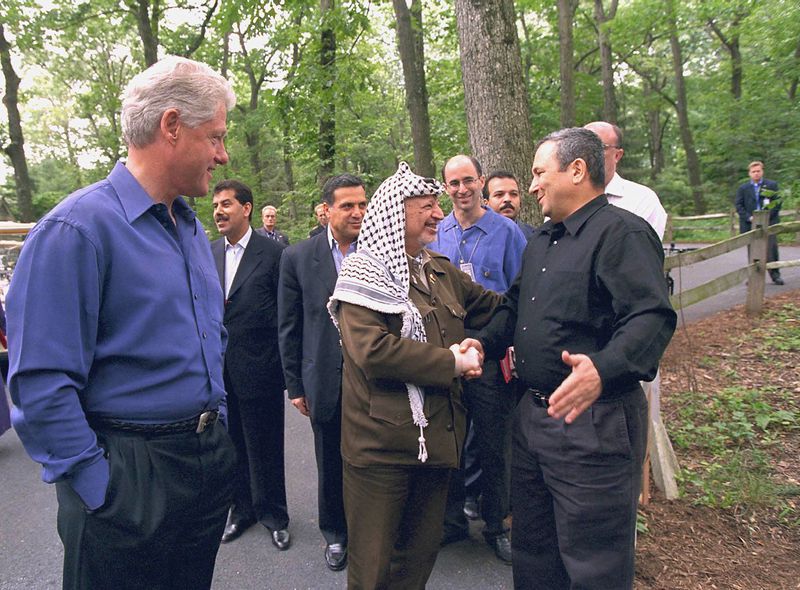
Ralph Alswang/AFP/ Getty Images
The failures of Camp David led Clinton to undertake a last ditch effort to salvage negotiations before he left office. At the outset of a Second Intifada, which would prove more bloody than the last, Clinton proposed his own parameters for peace.
In Clinton’s plan, 80 percent of Israeli settlers would remain in the West Bank, covering about 10 percent of the occupied land. Israel would have exclusive access to the utilities and certain roads that serviced them and would be allowed to create a security perimeter around the settlements. Palestinians would get some land adjacent to Gaza in exchange.
The rest of the West Bank would go to the new state of Palestine, which would also encompass all of Gaza. The new country would be demilitarized and supported by an international force. Palestinians would control the Arab neighborhoods of Jerusalem, including what is known to Muslims as the al-Aqsa Mosque, and Israelis would control the Western Wall.
Displaced Palestinians from around the world would have the right to return to the West Bank and Gaza, but not to their former homes in any land owned by Israel. Israel has generally opposed a right of return for Palestinians, which it “views as a tactic to undermine Jewish self-determination,” Mitchell and Sachar write. The return of the hundreds of thousands of Palestinians displaced in 1948 would erode Israel’s Jewish demographic majority.
Israel accepted the framework with reservations that Clinton said were “within [his] parameters.” Arafat also accepted the parameters but with reservations that Clinton deemed incongruous with an agreement. Part of the problem for Arafat was that the parameters required too many Palestinian concessions on land for settlers and on right of return, some foreign affairs experts have argued.
Clinton later wrote in his memoir that Arafat had made an “error of historic proportions.”
Carter saw Arafat’s decision differently, writing that “there was no possibility that any Palestinian leader could accept such terms and survive, but official statements from Washington and Jerusalem were successful in placing the entire onus for the failure on Yasser Arafat.”
This was the closest that the Israelis and Palestinians have come in recent years to achieving a peace agreement.
2002-2003: Various frameworks for peace are developed
The Second Intifada, which ended with a ceasefire in 2003 following significant loss of life, made official peace overtures difficult. But several initiatives that were not orchestrated by Israeli or Palestinian government representatives were nevertheless pursued during this period.
That included the 2002 Arab Peace Initiative proposed by the Saudi Crown Prince, which proposed Arab nations’ recognition of Israel in exchange for its withdrawal from the occupied territories, among other elements of a peace plan. It was embraced by many Arab countries and Palestinian leaders, but dismissed by the new Israeli Prime Minister Ariel Sharon’s government as a “nonstarter” just as it was launching a major invasion of the West Bank in response to the Second Intifada. There was also the 2003 Geneva Initiative, spearheaded by former Israeli and Palestinian officials, which aimed to provide a comprehensive plan for implementation of a two-state solution based on the framework discussed in the Clinton Parameters and the Arab Peace Initiative. It was also rejected by Sharon.

Odd Andersen/AFP/Getty Images
The US, Russia, the European Union, and the United Nations — together, the Quartet — also announced a roadmap for peace in 2003 that described progressive steps toward a two-state solution over the course of three years, with political, security, economic, humanitarian, and institution-building benchmarks.
The roadmap was grounded in then-US President George W. Bush’s belief that Palestinian militant violence was a primary obstacle to peace. He and the international community therefore demanded that Arafat step aside in favor of new Palestinian leadership to continue negotiations. At the time, there were still significant numbers of suicide bombings on Israeli and Jewish targets committed by Palestinian militants. Arafat agreed to step aside; the more moderate Mahmoud Abbas replaced him.
The Palestinians accepted the roadmap — despite the fact that Bush had made assurances to the Israelis that they would not be expected to totally withdraw from the occupied territories and that Palestinians would not have right of return to Israel. But the Israeli government, led by Sharon, demanded prerequisites that ultimately doomed the deal. Those included dismantling all Palestinian militant groups, precluding any reference to UN Resolution 242, and barring discussion of Israeli settlements.
“The practical result of all this is that the Roadmap for Peace had become moot,” Carter writes.
2005: Israel’s unilateral withdrawal from Gaza and some settlements in the West Bank
Despite previously advocating for expansionist policies in the occupied territories, Sharon announced an Israeli “disengagement plan” for Gaza in 2005 that involved the unilateral withdrawal of Israeli settlements and military forces. However, Israel maintained control of the Gazan airspace and cooperated with Egypt in administering its border with Gaza.
Approximately 8,500 Israeli settlers — some of whom had lived there for decades and resisted the plan — were removed from their homes, and some were compensated. Israel ceded control of Gaza to the Palestinian Authority, led by Abbas, who was elected its president that year. Israel also vacated four Israeli settlements in the West Bank.
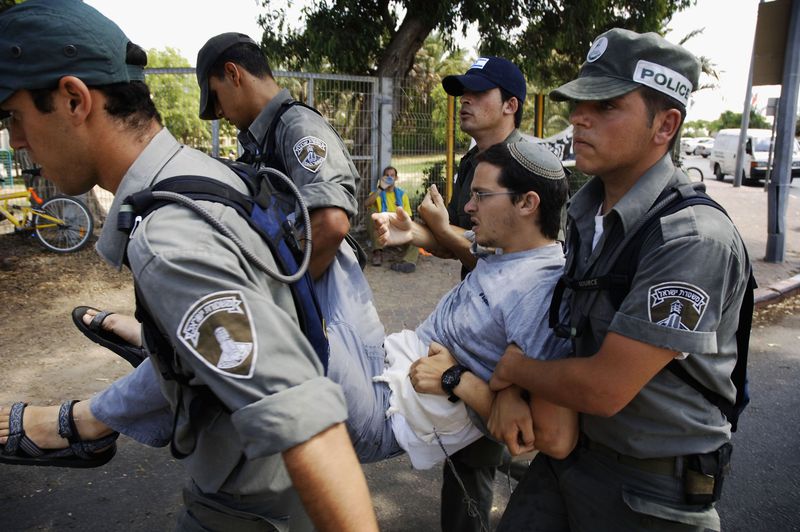
Shaul Schwarz/Getty Images
The move was surprising from Sharon, who had for years pursued a dream of a “Greater Israel,” understood by many Israelis as their biblical lands that encompass the Palestinian territories. It earned him a reputation as a peacemaker who was seeking to deescalate the situation. But as Dartmouth professor Bernard Avishai later argued in the New Yorker, the decision was “not meant to precede a negotiated settlement of any kind but to obviate the need for one.”
Sharon wanted to “cut Israel’s losses” in Gaza, Avishai argues, while pursuing his long-term goals of annexing Jerusalem, the Jordan Valley, and all major Israeli settlements in the West Bank, pushing the Palestinians well beyond Israel’s 1967 borders and behind the illegal “separation barrier” he had built. Sharon, however, suffered from a stroke soon after that would leave him incapable of fully carrying out that vision.
Hamas won a majority in the PA in the 2006 elections following the withdrawal. The US refused to recognize their new government and pressured Abbas’s government to overturn the results, helping spark a brief civil war that culminated in the group taking control of Gaza while the PA, led by politicians aligned with Abbas, continued to govern in the West Bank.
2008: Olmert’s peace offer
After the schism in the Palestinian government, Ehud Olmert, who became Israel’s prime minister after Sharon suffered from a stroke, decided to reopen peace talks with the PA in Annapolis, Maryland, for the first time since 2000.
Hamas supported the talks and was prepared to reverse its policy of rejecting Israel if an agreement that the Palestinian people would approve of could be finalized.
Olmert presented a proposal to Abbas that included significant territorial concessions, though the exact contours of the proposal are vague and were never fully disclosed. Reportedly, Olmert offered Palestinians 5.8 percent of Israeli land, consisting of lightly populated farmland, in exchange for 6.3 percent of the West Bank, encompassing major Israeli settlements. On other issues, however, there appeared to still be significant gaps between the Israeli and Palestinian positions on refugees, Jerusalem, and an Israeli withdrawal.
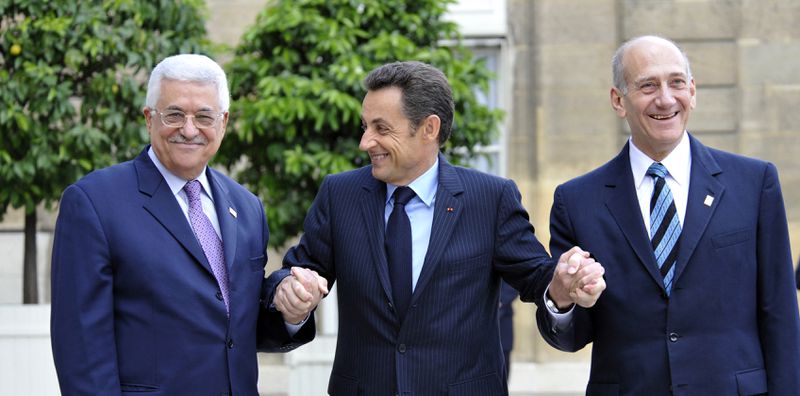
Gerard Cerles/AFP/Getty Images
Abbas did not accept the proposal, later saying he wasn’t provided enough detail, though Olmert speculates that Abbas was “entirely for it” and believes Abbas likely regrets that he did not sign the deal. In that respect, Abbas’s rejection of the offer is sometimes compared to Arafat’s reaction to the Clinton Parameters: It was “the best an Israeli prime minister had ever offered to a Palestinian leader” in terms of territory, Mitchell and Sachar write. But Abbas later stated that he believed the offer did not meet Palestinian aspirations for an independent and viable state.
Some reports suggest that Abbas was also concerned about the political situation in Israel at the time, as Olmert had announced his intention to resign over corruption allegations. Olmert later served a prison sentence for accepting bribes and committing obstruction of justice. Netanyahu succeeded him and rejected the talks as dangerous for Israel, raising questions as to whether he would have honored any agreement signed.
2014: Negotiations led by John Kerry collapse
Obama’s presidency began in 2009 with the ending of a Gaza war, known as Israel’s Operation Cast Lead, and he appointed George Mitchell, co-author of the 2016 book A Path to Peace, to shepherd peace talks. But the Israeli government was skeptical of Obama, and the heft Mitchell brought as a former negotiator with Northern Ireland did not directly translate to Israel and Palestine.
It quickly became clear Obama’s peace overtures weren’t working. Senior US officials had begun warning that because of the pace of Israel’s settlement expansion, the horizon of the two-state outcome was approaching, and human rights organizations were increasingly calling the situation in the West Bank apartheid. US Secretary of State John Kerry put his hat in the ring, setting a deadline of mid-2014 to reach a comprehensive agreement between the Israelis and Palestinians.
Kerry started with a series of confidence-building measures: Israel agreed to progressively release Palestinian prisoners in four parts while Palestinians agreed to halt the process of applying for membership as a country in international bodies. However, when Israel refused to release the fourth group of prisoners and continued to expand its settlements, Abbas reacted by applying for Palestine to be recognized by 15 UN and other international bodies.
Both sides also faced opposition within their own camps. Hamas rejected the talks, saying that Abbas had no authority to negotiate on behalf of Palestinians since no formal elections had been held in the Palestinian territories since 2005. The group called for a third intifada, though it never materialized.
Netanyahu’s Likud party proposed legislation to annex the Jordan Valley in direct contradiction of the US’s proposal during the talks that the area go to Palestinians. Hardliners also threatened to resign from Netanyahu’s government if he agreed to Israel’s 1967 borders as a starting point for negotiations.
These challenges led to a breakdown in the talks in April 2014.
2020: Trump’s “Deal of the Century”
Former President Donald Trump severely undermined the prospect of Palestinian autonomy, delivering several major wins for Israel that poisoned dialogue with the Palestinians.
He recognized the Israeli annexation of the Golan Heights, which Syria says should rightfully be its property — a decision later reaffirmed under Biden. He reversed decades of US policy and moved the American embassy from Tel Aviv to Jerusalem in 2018 — a decision made in recognition of the fact that Israel had made unified Jerusalem its capital, but that ignores Palestinian claims on East Jerusalem that are recognized by the UN. It’s now incredibly politically difficult for any American president to move the embassy back to Tel Aviv.

Mustafa Hassona/Anadolu Agency/Getty Images
The Trump administration also argued in 2019 that Israeli settlements in the West Bank are not necessarily illegal, lending legitimacy to Israel’s claims on the territories. Israel’s annexations and settlements are widely regarded as illegal under international law, and no other country has recognized them.
Though Trump unveiled a plan in 2020 that he hailed as the peace “deal of the century,” Palestinians vehemently rejected it. The proposal would have allowed Israel to absorb the vast majority of settlements in the occupied West Bank, home to more than half a million Israelis, required that Palestine be fully demilitarized, and rejected Palestinian refugees’ right of return outright. It would have also recognized Jerusalem as the capital of Palestine, while also impossibly recognizing Jerusalem as the “undivided capital” of Israel.
“We say a thousand nos to the Deal of The Century,” Abbas said at the time.

Jalaa Marey/AFP/Getty Images
Trump’s barefaced pro-Israel policies undermined the US’s ability to credibly moderate peace talks going forward. There’s also no one credible representative for Palestinians across the occupied territories with which to negotiate. Polling in recent years but before Hamas’s October 7 attack has shown that the PA, under Abbas’s leadership, is broadly unpopular when compared with Hamas, and as Mitchell and Sachar note, has become seen as “behaving like a security subcontractor easing the burden for Israel of the occupation.” That’s partially by the design of Netanyahu, who has propped up Hamas at the expense of a unified Palestinian voice in peace talks.
Even if there were strong representatives, Trump wasn’t interested in pursuing a peace plan. His administration created the Abraham Accords, which were normalization deals between Israel and Arab states like the United Arab Emirates, Bahrain, and Morocco (Arab states that had previously not recognized Israel); such deals did not include any progress on the Palestinian issue. Biden took up this policy, and his team put a major emphasis on bringing Saudi Arabia into the normalization fold during his first two and a half years in office. This Trump-Biden approach went against the Arab Peace Initiative and cut Palestinians out of the conversation.
2023: The US renews calls for a two-state solution
For years after Trump announced his framework, no meaningful attempts were made to reopen peace negotiations, with US President Joe Biden looking to turn his attention to other parts of the world, including China and Russia, and Israel signing normalization agreements with some of its Arab neighbors.
But that calculus changed with the onset of the war in Gaza. The Biden administration has offered its nearly unconditional support to Israel, but has raised concerns about Israel’s ability to achieve its stated goal of eliminating Hamas and its methods as civilian casualties skyrocket. It has also called for a renewed commitment to a two-state solution.

Mahmud Hams/AFP/Getty Images
The Biden administration’s focus on a two-state solution raises the question as to whether the window for that path to peace has passed. Israel’s occupation of the Palestinian territories has become entrenched, and its settler population in the West Bank has grown to at least 700,000, leading some observers — including Carter — to argue that the reality is that Israel and Palestine are a de facto one state.
“A system of apartheid, with two peoples occupying the same land but completely separated from each other, with Israelis totally dominant and suppressing violence by depriving Palestinians of their basic human rights. This is the policy now being followed,” Carter wrote in his 2006 book.
As the war continues, Biden has called on Israel to disentangle itself from Palestine, and has warned the country against trying to occupy Gaza once it concludes its offensive. But Following Hamas’s October 7 attack and the destruction Israel has wreaked in Gaza, reversing the status quo now seems more difficult than ever.
----------------------------------------
By: Nicole Narea
Title: The many, many times Israelis and Palestinians tried to make peace — and failed
Sourced From: www.vox.com/world-politics/2023/11/22/23971375/israel-palestine-peace-talks-deal-timeline
Published Date: Wed, 22 Nov 2023 12:00:00 +0000






